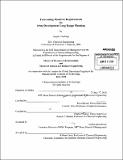Forecasting resource requirements for drug development long range planning
Author(s)
Thedinga, Angela (Angela Marie)
DownloadFull printable version (8.806Mb)
Other Contributors
Leaders for Global Operations Program.
Advisor
Ernst R. Berndt and Charles L. Cooney.
Terms of use
Metadata
Show full item recordAbstract
This thesis investigates the use of a task-based Monte Carlo simulation model to forecast headcount and manufacturing capacity requirements for a drug development organization. A pharmaceutical drug development group is responsible for designing the manufacturing process for new potential drug products, testing the product quality, and supplying product for clinical trials. The drug development process is complex and uncertain. The speed to market is critical to a company's success. Therefore, it is important to have an adequate number of employees and available manufacturing capacity to support timely and efficient drug development. The employees and manufacturing capacity can either be supplied internally or externally, through contract manufacturing organizations. This thesis formulates and empirically evaluates a simulation model designed using the Novartis Biologics drug development process and is adaptable to other pharmaceutical organization. The model demonstrates 7% accuracy when compared with historical data, and estimates within 13% of the currently accepted manufacturing capacity forecasting tool. Additionally, three case studies are included to demonstrate how the model can be used to evaluate strategic decisions. The case studies include: a drug development process improvement evaluation, an outsourcing evaluation, and an "at risk" development evaluation.
Description
Thesis (M.B.A.)--Massachusetts Institute of Technology, Sloan School of Management; and, (S.M.)--Massachusetts Institute of Technology, Dept. of Chemical Engineering; in conjunction with the Leaders for Manufacturing Program at MIT, 2010. "June 2010." Cataloged from PDF version of thesis. Includes bibliographical references (p. 64).
Date issued
2010Department
Leaders for Global Operations Program at MIT; Massachusetts Institute of Technology. Department of Chemical Engineering; Sloan School of ManagementPublisher
Massachusetts Institute of Technology
Keywords
Sloan School of Management., Chemical Engineering., Leaders for Global Operations Program.